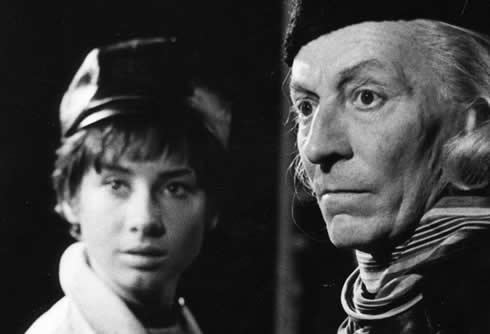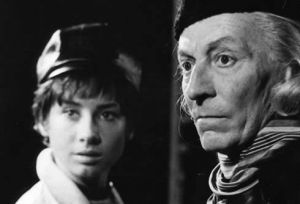
by Laura Jung
I come to you, the fanbase of TLF, as a newbie, and let me just say what a pleasure and privilege it is to join you and the esteemed contributors to this amazing blog! I, like many of you, am a rabid Doctor Who fan. While the 9th Doctor was my first, and the 10th Doctor will always be my doctor, I have recently gone back in time and space to explore vintage Doctor Who. In what I hope will be a series of guest appearances at The Learned Fangirl, we’ll talk about issues of gender, race, sexuality, heteronormativity, and Stephen Moffat’s obsession with Mum in early and recent episodes of Doctor Who. Alons-y!
In 1964, William Hartnell became the very first Doctor. He was a white-haired, sort of crotchety fellow, with a slightly conniving side. This iteration of the Doctor invariably played a paternalistic role. And while the Eighth, Ninth and Tenth Doctors we know and love today are often in awe of their human counterparts, or the love interest, the First Doctor seems much more entrenched in the all-knowing father (or grandfather) role with much less of that fantastic childlike wonder. Even his body language was paternalistic with pats on the heads or hands of his female counterparts. With a paternal Doctor and gender roles being well defined around him, the early days of the show firmly reinforce patriarchy. The First Doctor’s companions will help me explain.
The Doctor’s Many Companions
In The Aztecs series there were three, count ‘em, three companions traveling with the Doctor. There was Barbara, who decided it would be a good idea to take an artifact from an Aztec burial, then assumed the role of a reincarnated Aztec deity and tried to “improve” Aztec cultural practice by “saving” it from its “savage” and “barbaric” ways. (For now, I am going to leave aside the obvious colonialist connotations apparent in the series, but they warrant discussion.) Susan is a younger, sort of girlish character, who kept calling the Doctor “grandfather,” which only reinforces the Doctor’s paternalism. And finally, Ian Chesterton takes on the typically masculine role of an Aztec warrior and the protector of his women-folk companions.
Women: Know Your Place!
What we learn from Barbara is that women are suspect, as is the case with Barbara whose legitimacy, intent, and actions are questioned throughout the series by every male character. Barbara is ultimately proved a fraud and a liar, having committed the womanly sin of deceiving the only (Aztec) man she trusted.
This companion helps rectify a subtle, but no less nefarious, gender discrimination when she demonstrates that women are not to be trusted. And it isn’t just Barbara. The Doctor is “engaged” to an Aztec woman, which for him seems to be a part of his cunning plans for escape, but she is later tasked with deceiving the guards holding young Susan hostage, further casting women in the role of deceiver and manipulator. Never mind that the Doctor and virtually all the other male characters are involved in enormous plots of deception, women tend to be the only ones for whom this is deemed a deviant behavior.
Susan performs another gendered stereotype. Women must learn and adhere to their “proper” place in society, which Susan confirms as she reads through and articulates a sort of book of etiquette given to her by the male counterparts in the Aztec society. The etiquette guide includes such gems as: stay at home; tend the garden; keep your eyes downcast when meeting your betrothed.
Women’s agency is eradicated as their roles are prescribed for them. We should resist the temptation to argue that the Aztecs are the patriarchs here and not the Brits, because Susan doesn’t seem to mind the roles laid out for her, with one exception, betrothal.
When Susan balks at the idea of betrothal (but conspicuously not to any of the other behaviors prescribed for women) she lures the audience into judging the Aztec civilization as backward in comparison to “modern” England, despite the fact that contemporary societies are perfectly content to keep women just out of grasp of meaningful power.
So … What’s the big deal?
This highlights two gendered issues. First, the role of woman is conceptualized in relation to a male counterpart. A woman is< em> supposed to be married. All the single ladies, yes, all the single ladies … continue to be defined in relation to men.
Harumph. Second, explicit domination of women in the form of betrothal is no longer necessary, because women have internalized the behaviors that are expected of us. Sure, women can marry “whoever they want”…as long as it is a heterosexual male of a similar race and class. Transgressing any of these norms could result in dismissal of the partnership as illegitimate or a societal demotion in social stature or both. So really, we have embodied betrothal such that it no longer has to be enforced explicitly. (This phenomenon, mercifully, is starting to change in some parts of the world. Same-sex marriage is gaining recognition and while we are by no means beyond issues of race and class today, stigmas attached to multi-racial partners are not as entrenched as they were a few decades ago.)
What about the Dudes?! (Or Patriarchy is Bad, mmmkay)
And the men! Oh, the men. There are a few characters that perform various aspects of heteronormativity that merit discussion, too. The Aztec warrior, Ixta, is the most useful for our purposes. Ixta is an aggressive, physical warrior. He is not portrayed as particularly intelligent, just the sum of his muscular parts. Ixta and Ian engage in hand-to-hand combat a few times during the series and Ian always manages to best the Aztec warrior. Ian and Ixta both must demonstrate their power and dominance, and thus their masculinity. Ian must be the protector of Barbara and Susan (despite the fact that Barbara seems to have been doing fine on her own) and he would have a hard time doing that if he couldn’t maintain power through the successful performance of masculinity (I’m suddenly reminded of Rory the Centurion – but let’s hold that thought for later discussions). Men, I think you’ll agree that just as casting a woman as subservient, a deceiver, or as helpless beings in need of protection, stereotyping men as either brainless brawns or, the opposite, nerdy weaklings, leaves out various shades of diversity among the men-folk. It also creates a standard of masculinity that is unrealistic and deepens patriarchal gender divisions, which negatively affect men, too.
Knowing is Half the Battle
Fans of the First Doctor, don’t despair! We can still enjoy the magic and wonder that is Doctor Who. These problematic interpretations of gender do evolve over the course of the Doctor Who experience as time will demonstrate. Hartnell obviously wasn’t the only Doctor, and John Lucarotti was only the writer between 1964 and 1966, which was a time when the human collectivity was learning some hard lessons (think the Civil Rights movements in the US and the UK and decolonization of countries in Africa) that might not have impacted Lucarotti’s imaginary.
How women are portrayed just a few years after this series is quite different, even if there are still lingering issues, and the paternalism of the Doctor begins to change, too. But it shouldn’t be unexpected that residues and reminders of patriarchy crop up in our favorite sci- fi series. Patriarchy is still the system under which we operate today, and as such will inevitably infect our favorite diversions until we manage to dismantle it.
Laura S. Jung is working on a PhD in Anthropology from American University. Have feedback? Follow her on twitter @madametalksalot and let her know what you think!



hello! your article is very interesting, but it did confuse me on a few points. as i understand it, Susan is a high school student who gets followed home by two of her teachers, Ian and Barbara. Ian ends up marrying Barbara at one point if I recall correctly. So couldnt the instances of Ian being the protector of Barbara and Susan also be attributed to the fact that he is in love with one, therefore trying to protect his love and also is the teacher in the teacher-student relationship he has with Barbara?
Also arranged marriages are still the norm in a number of cultures in today’s world, so why would it be strange that in the 1960’s a TV show would portray a civilization such as the Aztecs as having arranged marriages?
*teacher-student relationship he has with SUSAN, not Barbara. sorry!